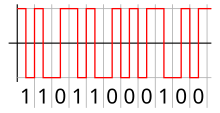Line code
In telecommunications, a line code is a pattern of voltage, current, or photons used to represent digital data transmitted down a communication channel or written to a storage medium.Line codes are chosen to meet one or more of the following criteria: Most long-distance communication channels cannot reliably transport a DC component.There are three ways of eliminating the DC component: Bipolar line codes have two polarities, are generally implemented as RZ, and have a radix of three since there are three distinct output levels (negative, positive and zero).If the runs are too long, clock recovery is difficult; if they are too short, the high frequencies might be attenuated by the communications channel.A line code will typically reflect technical requirements of the transmission medium, such as optical fiber or shielded twisted pair.






pulse-amplitude modulationnon-return-to-zerobipolar encodingManchester encodingdifferential Manchester encodingbiphase mark codeMLT-3 encodingPassbandmodulationSC-FDETC-PAMHierarchical modulationSpread spectrumDemodulationMultiplexingtelecommunicationstransmittedcommunication channelstorage mediumunipolarbipolarManchester codetransmission mediumdata storage mediumtransmission linedifferential signalingbasebandpulse shapingmodulatedRF signalfree-space optical communicationremote controlbar codehard drivetape driveoptical discspectral densityDC componentDC coefficientrunning totalDC-balancedconstant-weight codecode wordInterleaved 2 of 5paired disparity codealternate mark inversion8b/10bscrambler64b/66b encodingcoded mark inversionMiller encodingdifferential codingsyncwordsclock recoveryrun-length limitationrecording headmodulatingbit sliphard disk drivesBlu-rayde facto standardsoptical fibershielded twisted pair6b/8b encoding8b/10b encoding128b/130b encodingEFMPlusEight-to-fourteen modulationcompact discsHamming codeHybrid ternary codedifferential ManchesterMark and spaceModified AMI codesModified frequency modulationNon-return-to-zero, invertedPulse-position modulationReturn-to-zeroAlternate-Phase Return-to-ZeroCarrier-Suppressed Return-to-ZeroPhysical layerSelf-synchronizing codeK. Schouhamer ImminkWayback MachineFieldbus FoundationKees Schouhamer Imminkpublic domain materialGeneral Services AdministrationMIL-STD-188Line codingUnipolar encodingOn–off keyingReturn to zero (RZ)ManchesterDifferential Manchester/biphase (Bi-φ)Conditioned diphaseModified AMI codeDelay/Miller encodingBit rateDigital signalDigital transmissionEthernet physical layerPulse-code modulationSerial communication